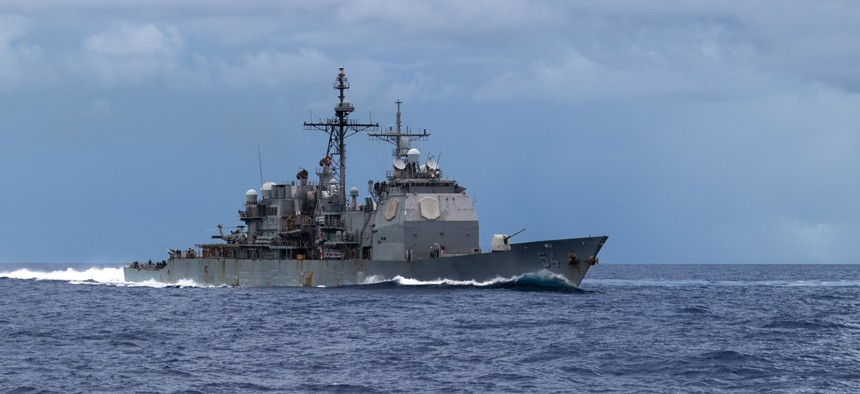
Five Ticonderoga-class cruisers are on the proposed cut-list. Petty Officer 2nd Class Nicholas Bauer
Navy Gets Budget Bump But Fleet Would Shrink Under Biden Request
Increasing spending by just 5 percent and cutting two dozen ships, the Navy asks for modest budget changes as it wraps up a new fleet plan expected to be heavy on uncrewed vessels.
How do you build a bigger fleet? In 2023, U.S. Navy leaders say, part of the answer will be getting rid of two dozen ships–out of nearly 300–that are consuming funds better spent elsewhere.
The Biden administration is requesting a total of $180.5 billion for the Navy in 2023, nearly 5 percent more than the amount enacted by Congress for the current fiscal year, according to documents sent to lawmakers on Monday. The Marine Corps is seeking $50.3 billion, nearly 2 percent over this year’s enacted amount.
“I would admit, a lot more money than we thought we would get at the beginning of the process,” said one Navy official who briefed reporters on the condition of anonymity on Friday.
In their spending proposal, Navy leaders are asking to decommission 24 ships, “16 of which somewhat early,” Rear Adm. John Gumbleton, the service’s deputy assistant secretary for budget, told reporters on Monday.
The administration’s Navy budget documents do not contain the long-range shipbuilding plan that Chief of Naval Operations Adm. Mike Gilday has said will come out this year. Gilday has publicly advocated for a fleet of 500-plus crewed and uncrewed ships.
In the meantime, the proposed cut-list includes nine Freedom-class littoral combat ships (down from a reported 10), five Ticonderoga-class cruisers (the Navy had hoped to retire seven), two Los Angeles-class submarines, four landing dock ships, two oilers, and two expeditionary transfer docks (both less than a decade old).
If lawmakers permit the Navy to retire them all, it will save $3.6 billion over the next five years, Gumbleton said.
And if not? “Sometimes Congress opines that they don’t want us to decommission a ship,” and lawmakers choose instead to bump up the Navy’s operations and maintenance budget, the admiral said.
Meredith Berger, who has been performing the duties of Navy undersecretary since August, told reporters that “it’s a difficult decision” to retire these ships but that “there are real costs” to keeping them around. The Freedom-class LCS ships are consuming $50 million a year, she said. Their anti-submarine mission will be taken up by the Constellation-class frigates, the fourth of which will be ordered this year, Gumbleton said.
In all, the 2023 proposal would order nine Battle Force ships, including 2.5 Virginia-class attack submarines plus advanced procurement funding for more; two destroyers at about $2.5 billion apiece; that Connie-class frigate for $1.2 billion; the 12th and final LPD-17 amphibious transport dock; and a $97 million salvage ship. The Navy is also seeking to buy two secondhand sealift ships, which Gumbleton praised as a cost-effective measure. The budget also funds the planned refueling and overhaul of the aircraft carrier Harry S. Truman—which is currently in the eastern Mediterranean doing deterrent operations near Russia’s war on Ukraine.
Truman’s overhaul is part of the reason that more than half of the shipbuilding budget—56 percent—is going toward nuclear-powered vessels. And that share will climb over the next few years as the Columbia class of ballistic missile submarines enters production, Gumbleton said.
Over the next five years, the Navy documents say, the Biden administration plans for shipbuilding spending to remain in the mid-$20 billions, totalling about $150 billion by 2027. By then, the size of the Battle Force fleet will have drifted downward from the current 297 to 280.
Naval aviation
This year could be the first in decades with no planned purchases of Boeing’s F/A-18 Super Hornet (née McDonnell-Douglas’ Hornet). But Congress added Hornets last year and could do so again. Also gone are Navy V-22 Ospreys (in several variants), while the last batch of E-2D radar planes will arrive this year.
But the year will bring the first order of MQ-25 Stingrays: three refueling drones that will be “paving the way into unmanned carrier aviation,” Gumbleton said.
Overall, naval aviation—aircraft, helicopters, and drones for the Navy and Marine Corps—aims to spend $16.8 billion this year.
One important part is classified: the Next Generation Air Dominance program, which could produce a 6th-generation combat jet, new drones, or maybe both.
Marine Corps
The Marines, who are still amid the generational shift to a lighter force prescribed by Commandant Gen. David Berger, plan to buy a few less F-35Bs and Cs in the next few years: about 16 of the former and four of the latter. Like the Navy, they intend to stop buying V-22 tiltrotors.
The Corps is proposing to spend a bit more on “readiness”: $3.8 billion, up from this year’s $3.5 billion. But “ground equipment depot maintenance” is funded at “80% of the total requirement,” which seems to augur a future readiness bill that will come due.
The Marines are also planning to buy electric “non-tactical vehicles,” in a bid to help reduce climate change.




